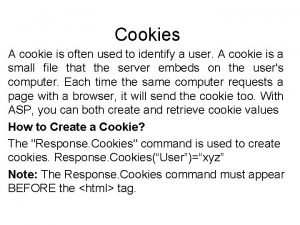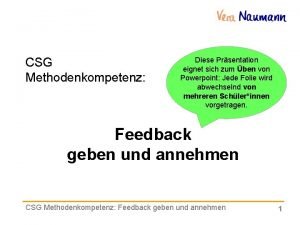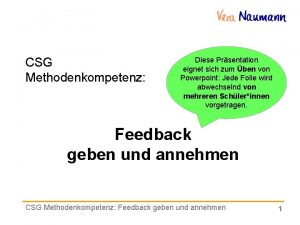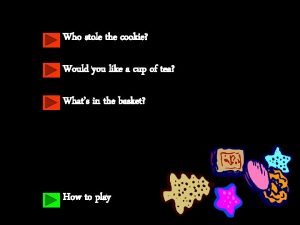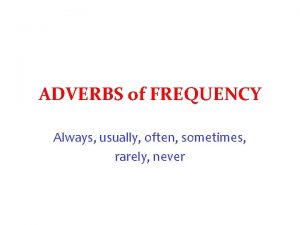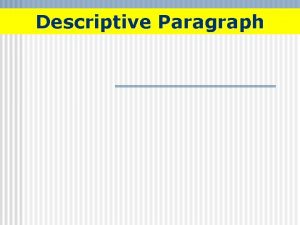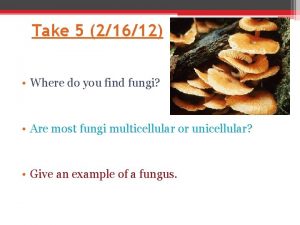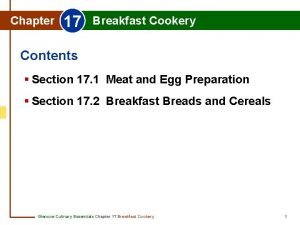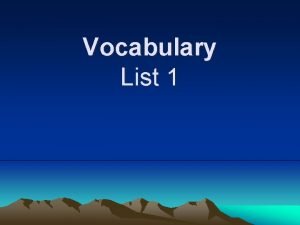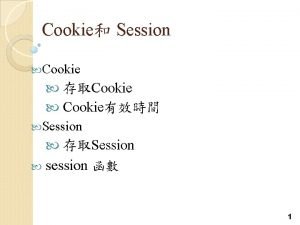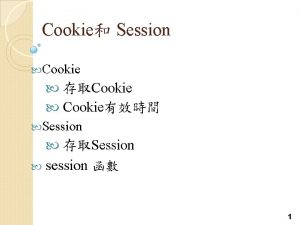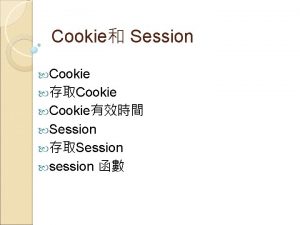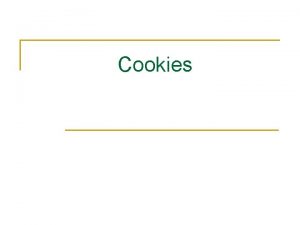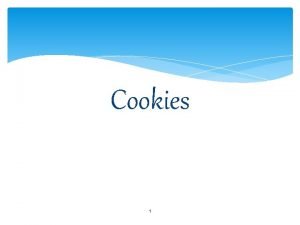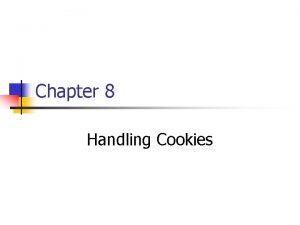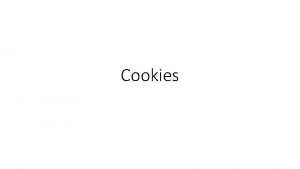Cookies A cookie is often used to identify












- Slides: 12

Cookies A cookie is often used to identify a user. A cookie is a small file that the server embeds on the user's computer. Each time the same computer requests a page with a browser, it will send the cookie too. With ASP, you can both create and retrieve cookie values How to Create a Cookie? The "Response. Cookies" command is used to create cookies. Response. Cookies(“User”)=“xyz” Note: The Response. Cookies command must appear BEFORE the <html> tag.

• Deleting a cookie — physically removing it from the user's hard disk — is a variation on modifying it. You cannot directly remove a cookie because the cookie is on the user's computer. However, you can get the browser to delete the cookie for you. • The following command will delete the cookie. Response. Cookies["Hello"]. Expires = Date. Time. Now. Add. Days(-1); Response. Cookies["Hello"]. Expires(#May 10, 2012#)

Application Object • An application on the Web may consists of several ASP files that work together to perform some purpose. The Application object is used to tie these files together. • The Application object is used to store and access variables from any page. • The Application object holds information that will be used by many pages in the application (like database connection information). The information can be accessed from any page. The information can also be changed in one place, and the changes will automatically be reflected on all pages.

Application Variables • Application variables are also available to all pages in one application. Application variables are used to store information about ALL users in one specific application. • Application variables can be accessed and changed by any page in an application. • You can create Application variables in "Global. asa" like this: • <script language="vbscript" runat="server"> Sub Application_On. Start application("vartime")="" application("users")=1 • End Sub </script> • In the example above we have created two Application variables: "vartime" and "users".

Application Object Collection Description Contents Contains all the items appended to the application through a script command Static objects Contains all the objects appended to the application with the HTML <object> tag

Application object methods Method Description Contents. Remove Deletes an item from the Contents collection Contents. Remove. All Deletes all items from the Contents collection Lock Prevents other users from modifying the variables in the Application object Unlock Enables other users to modify the variables in the Application object

Application Events Description Application_On. End Occurs when all user sessions are over, and the application ends Application_On. Start Occurs before the first new session is created

The Session Object • When you are working with an application on your computer, you open it, do some changes and then you close it. This is much like a Session. The computer knows who you are. It knows when you open the application and when you close it. However, on the internet there is one problem: the web server does not know who you are and what you do, because the HTTP address doesn't maintain state.

• The Session object stores information about, or change settings for a user session. • Variables stored in a Session object hold information about one single user, and are available to all pages in one application. Common information stored in session variables are name, id, and preferences. The server creates a new Session object for each new user, and destroys the Session object when the session expires.

Session Start A session starts when: • A new user requests an ASP file, and the Global. asa file includes a Session_On. Start procedure • A value is stored in a Session variable • A user requests an ASP file, and the Global. asa file uses the <object> tag to instantiate an object with session scope

Session End • A session ends if a user has not requested or refreshed a page in the application for a specified period. By default, this is 20 minutes. • If you want to set a timeout interval that is shorter or longer than the default, use the Timeout property. • The example below sets a timeout interval of 5 minutes: <% Session. Timeout=5 %>

Session Object Methods • Session. Contents. Remove(“session_name”) • Session. Contents. Remove. All() • Session. Contents. Count()
 A cookie is often used to identify
A cookie is often used to identify Cookie lemon cookie feedback
Cookie lemon cookie feedback Cookie lemon cookie feedback
Cookie lemon cookie feedback Cookie monster who stole the cookie
Cookie monster who stole the cookie Cookie monster images
Cookie monster images Always, usually, often sometimes never
Always, usually, often sometimes never Diagonal lines are often used to
Diagonal lines are often used to Spatual order
Spatual order Ascomycotes
Ascomycotes What is a crab dolly? when is it most often used?
What is a crab dolly? when is it most often used? Breakfast cookery
Breakfast cookery Static budgets are often used by
Static budgets are often used by Expostulation synonym
Expostulation synonym
